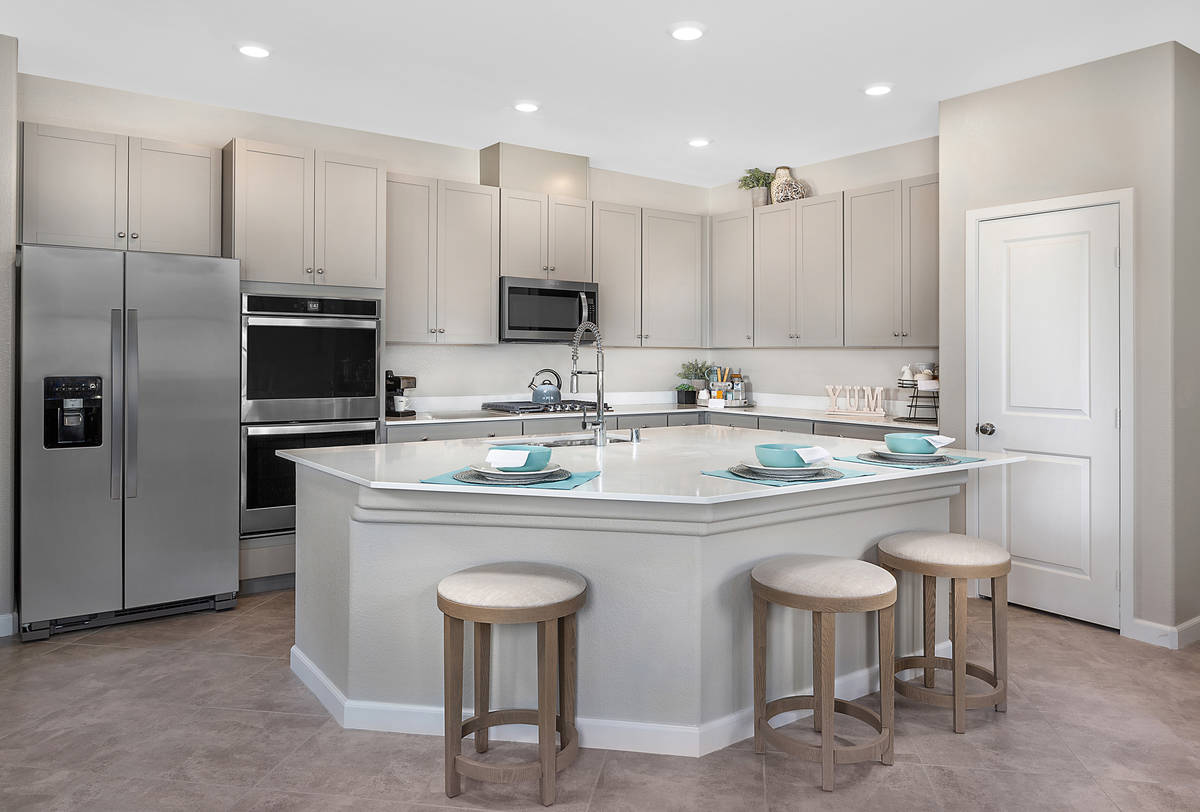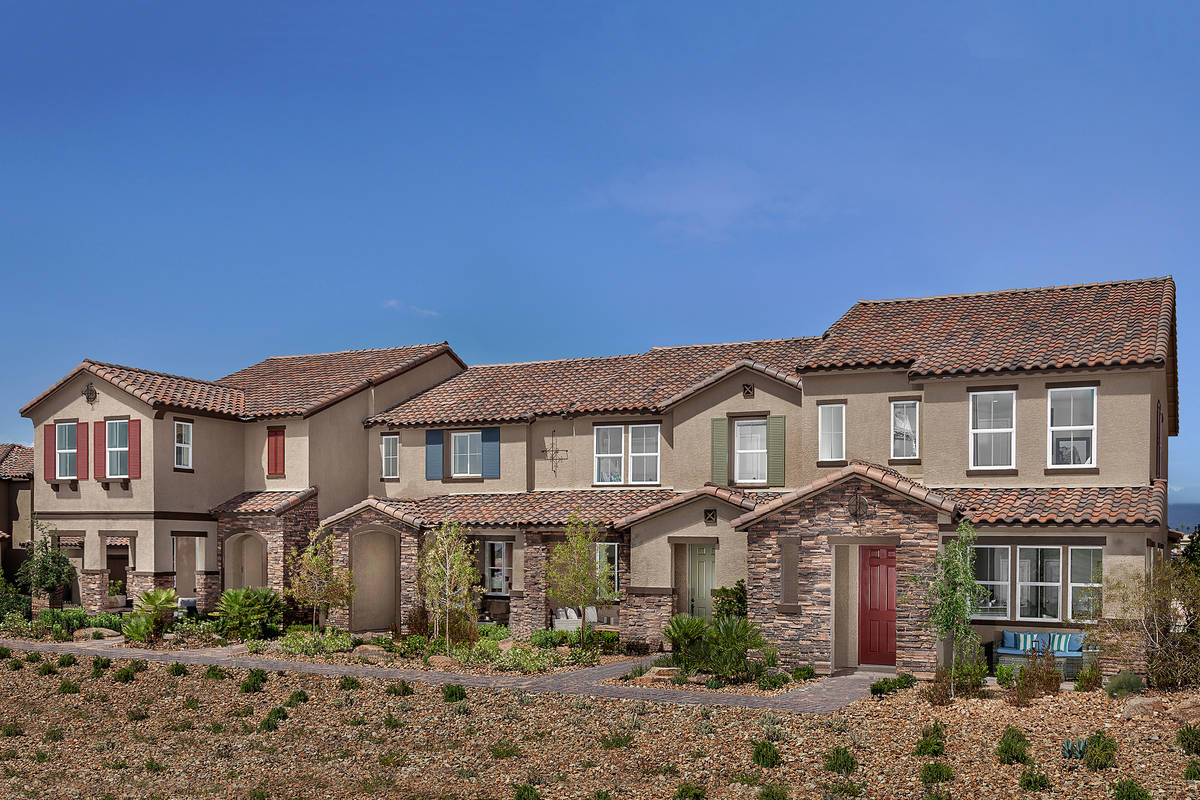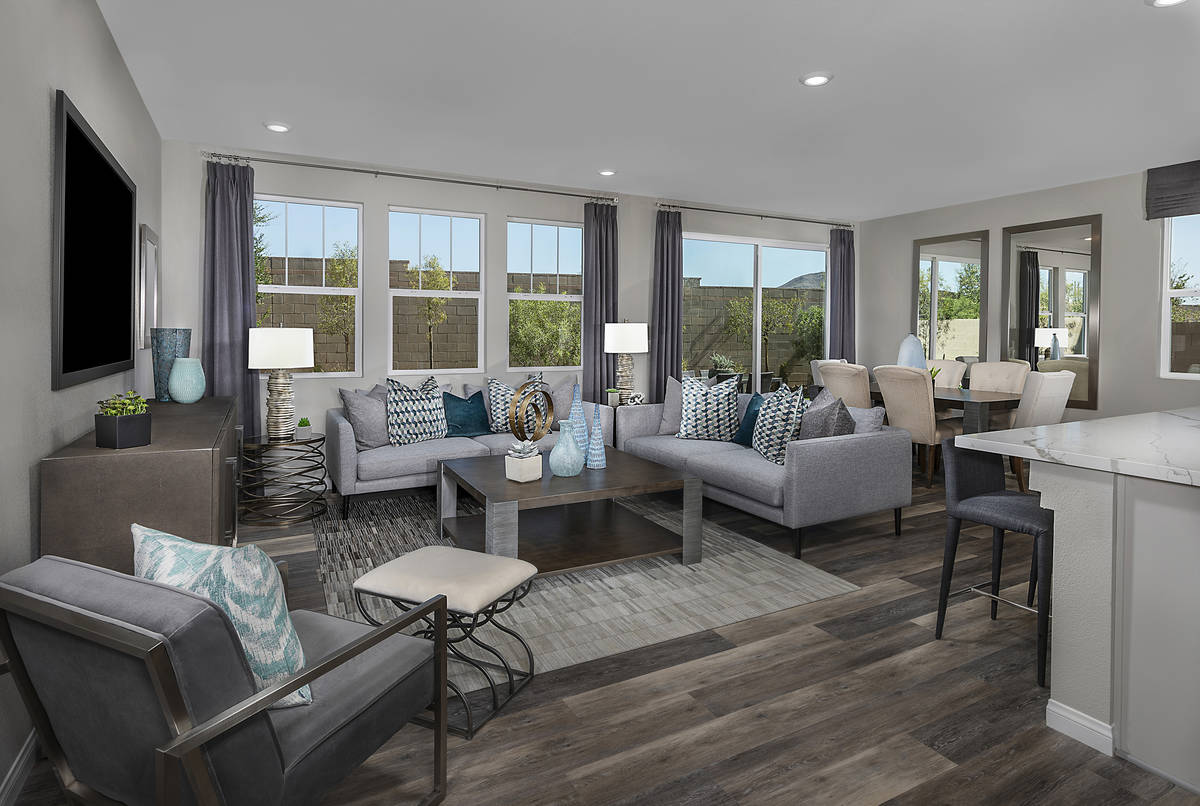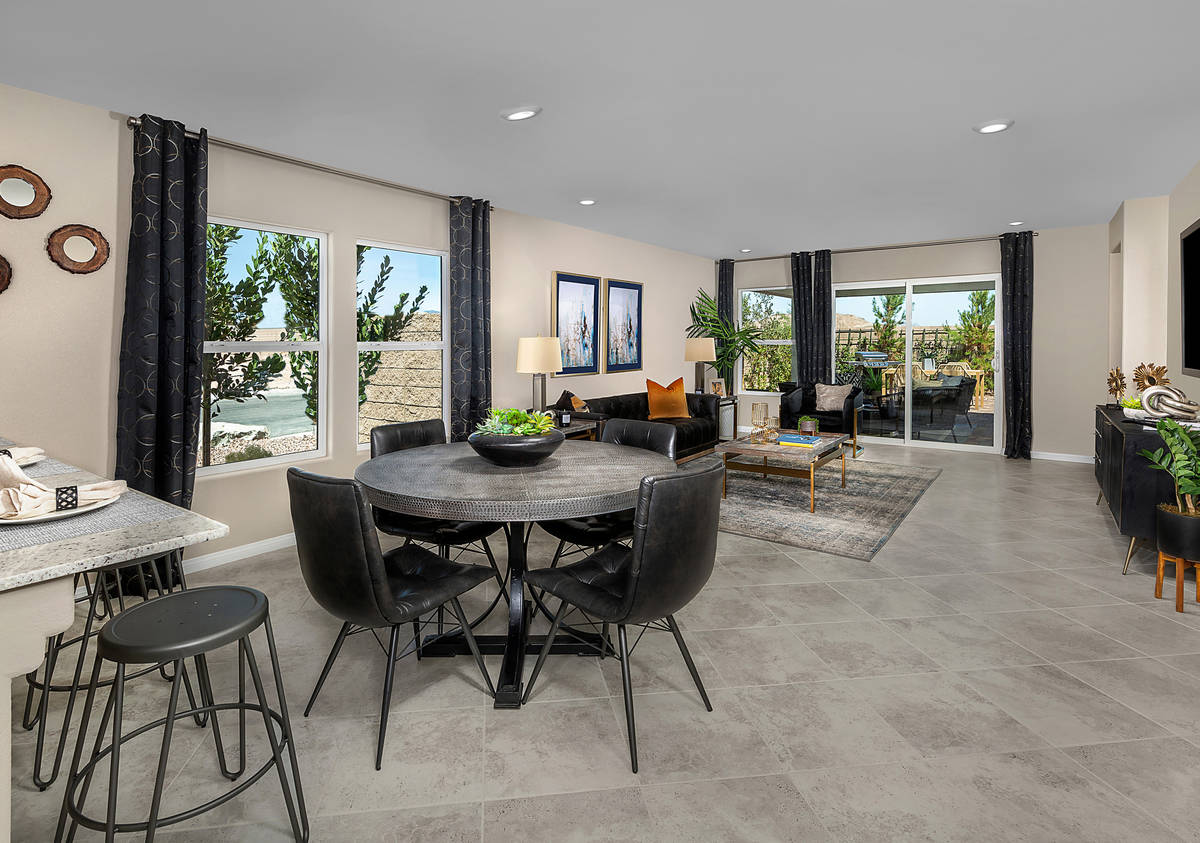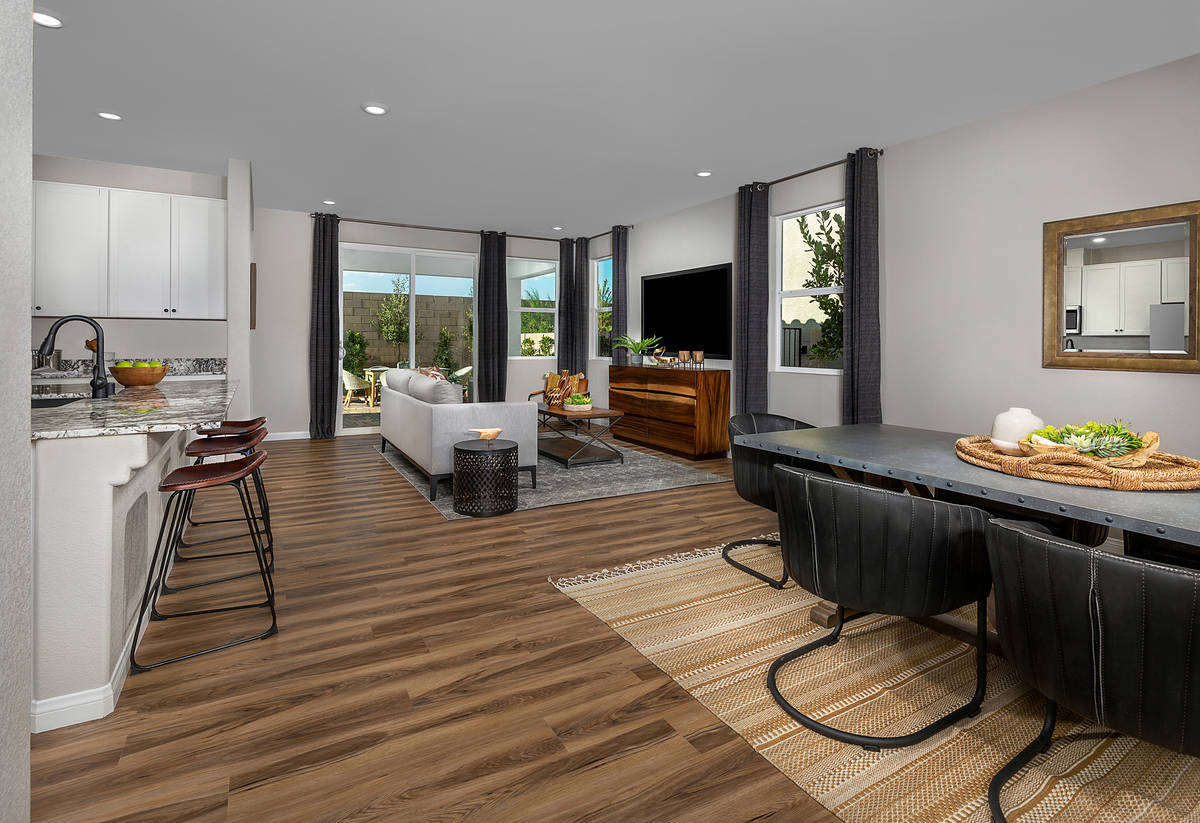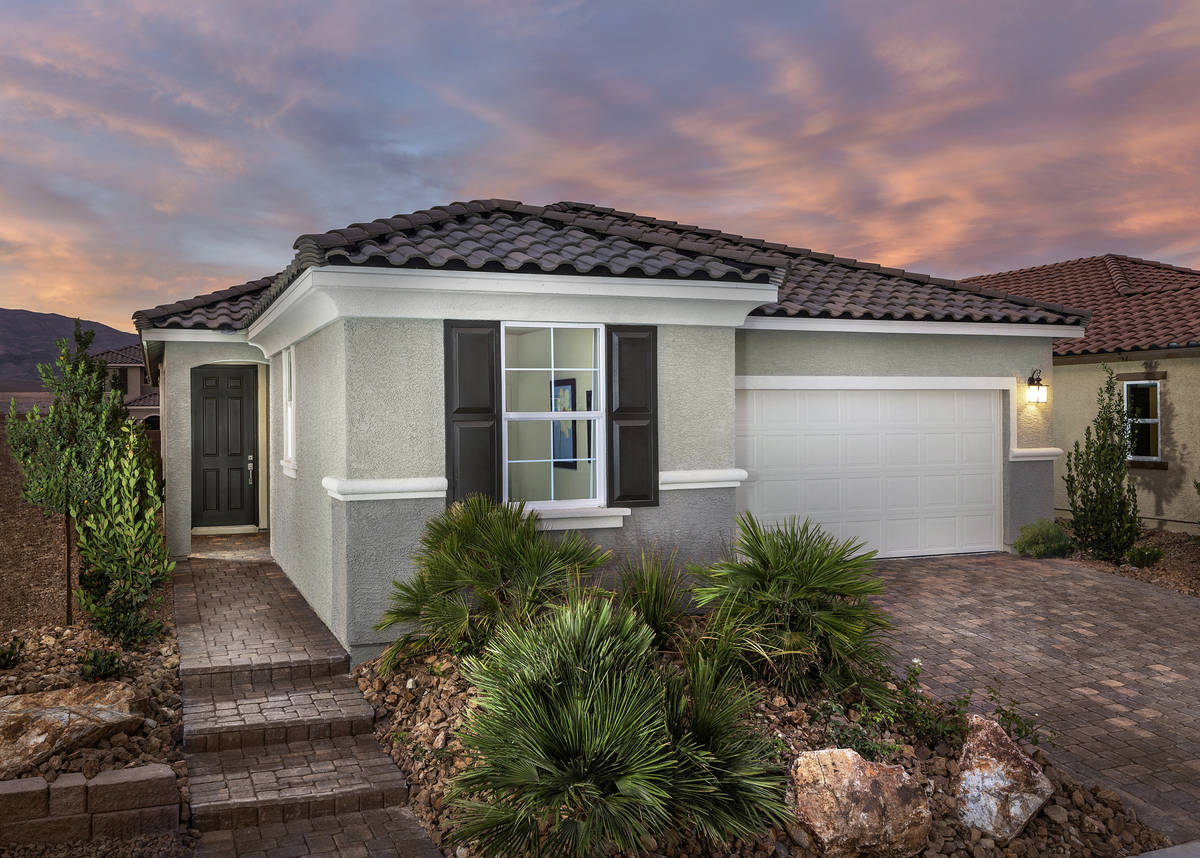Before COVID-19 slowed the Las Vegas housing market, builders during the first quarter sold more affordable new homes than in the first three months of 2019, and nothing epitomized that more than the breakout of the Villages of Tule Springs and Valley Vista — two new master plans in North Las Vegas.
Builders and analysts said that trend is expected to continue with the reopening of the economy and even help the housing market rebound from the coronavirus. North Las Vegas, where affordable new homes have been a focal point, recorded 709 net sales in the first quarter, nearly matching the 716 in the southwest valley that has dominated the housing market for more than a decade.
Valley Vista, a project of DR Horton that opened in September 2018 with plans for 4,000 homes, had 246 net sales through the end of March, up from 26 in the first three months of 2019.
Tule Springs, a project of KB Home, Lennar Homes and Pardee Homes, recorded 156 net sales between January and March, nearly doubling the 85 sales in the first quarter of 2019. It opened in 2018 with plans for 8,700 homes on 1,280 developable acres.
Both communities were aided by being the lowest-priced master plans with Tule Springs’ $309,836 median closing price, down 6.5 percent from $331,536 during the first quarter of 2019. Valley Vista had a median price of $319,220, down 1.4 percent from a year ago, when it was $323,871.
The lowering of prices has been helped by the continued emergence of the town home market that saw in excess of 20 percent market share in December and January — levels not seen since the 1990s — and upper teens in the first quarter.
A year ago through the end of the first quarter, North Las Vegas had 17 percent of the new home market. It stood at 23 percent through the end of March. Between mid-March and mid-April when the economy first shut down, North Las Vegas led the way in net sales ahead of Henderson, the northwest valley and southwest, which was fourth.
With a focus on much-needed affordability in the valley, the North Las Vegas home market has helped lead the way in an increase in home sales below $400,000 so far this year.
Home Builders Research reported about 63 percent of the net sales during the first quarter were priced below $400,000. A year ago, that was just over 50 percent within that price range when labor and material costs were cheaper.
Through April, the new home median closing price has now posted year-over-year declines for nine of the last 10 months, including six straight months, according to Home Builders Research.
That was demonstrated by sales in the $200,000 to $300,000 range that went from 485 a year ago to 732 this year. It made up 22.7 percent of the market, up from 15 percent a year ago.
In the $300,000 to $400,000 range, there were 1,259 sales or 39.1 percent, up from 1,140 or 34.8 percent in 2019.
Less than 1 percent of the sales were for homes less than $200,000. There were 26 this year, down from 29 in the first quarter of 2019.
The drop off was visible most in the mid-price ranges. The 552 sales of $400,000 to $500,000 made up 17.1 percent. That’s down from the 638 or 19.5 percent a year ago.
In the $500,000 to $750,000 range, there were 413 net sales or 13 percent of the marketplace. That is down from 672 or 20.5 percent in 2019.
In the category above $750,000, there were 234 sales or 7.3 percent this year compared with 310 or 9.5 percent a year ago, according to Home Builders Research.
North Las Vegas
Valley Vista and Tule Springs are moving up the ladder among the valley’s master plans in terms of new home net sales.
Summerlin led the way with 471 sales, up 41 percent from the first quarter of 2019’s 333 sales.
Inspirada recorded 189 sales, up from 172 or 10 percent. Cadence in east Henderson had 176 sales, up from 161 or 9 percent. Skye Canyon had 175 sales, up from 129 or 36 percent.
Among other master plans, Lake Las Vegas had 76 sales, up 69 percent from 45 in 2019. Southern Highlands had 46 sales, up from 41 a year ago or a 12 percent gain.
None of those sales include custom homes done by those who bought their own lot and hired a builder.
The North Las Vegas new home market has benefited from lower land prices compared to other parts of the valley and demand for housing because of jobs created by Amazon, Nellis Air Force Base and the VA Medical Center and others.
Brian Kunec, president and regional general manager of KB Home’s Las Vegas and Seattle divisions, said one of the reasons KB invested heavily in North Las Vegas was to offer entry-level affordable housing.
“With (lower) land prices and the buyer pool, the main driver up there is affordability,” Kunec said. “We’re happy with our presence up there, and there’s a lot of good stuff going on. There’s a big shortage of housing and that still continues, now. And, I believe coming out of this, the housing shortage will be even worse. People continue to move to Las Vegas even during these times. People are tired of renting and want to buy a home. We firmly believe in our business model as an entry-level affordable builder.
“Over the last couple of years, you have seen many other public builders start to rotate into entry-level product lines who never had much of an affordable entry-level presence.”
KB Home has a town home product of 1,366 square feet at Tule Springs that starts at $224,000, Kunec said. A single-family home at 1,558 square feet starts at $254,490.
North Las Vegas is one of the few markets that meets that affordability gap and those big sales volumes will continue, Kunec said. He said KB gets casino workers, health care workers and military buyers.
“Coming out of a recession, people won’t be looking for housing to be 60 to 70 percent of their monthly expense,” Kunec said. “They’re looking for smaller homes that take up less of their budget. It’s working, especially during these times, because North Las Vegas is driving the most sales. As the southwest and Summerlin continues to escalate in price point, you’re going to have more buyers migrate in that direction because they’re looking for that affordable segment.”
Even Summerlin is placing an even greater emphasis on affordability with the opening of its newest village north of Far Hills Avenue in a community called Redpoint. It will be denser and more affordable with prices in the high $200,000s and low $300,000s.
Nicole Bloom, division president at Richmond American Homes in Las Vegas, which has an active presence in North Las Vegas in six communities for first-time and move-up buyers (including the new community of Sedona Ranch), said they’re even interested in building in Tule Springs, where they see the opportunity.
“Like most builders we’re kind of evaluating the market before we make any big land decisions,” Bloom said. “We’re definitely interested in Tule Springs. That’s a great location and eventually we will end up there.”
Bloom said Richmond has long been pushing to bring their average sales price down — one with a two-story single-family home product of 1,450 square feet to 1,950 square feet that on the low end at Sedona Ranch costs in the $250,000s.
“The other thing that a lot of builders and us included have done is 1,500-square-foot urban duplexes, which is the first time we have done attached in Vegas,” Bloom said. “We have a version of that in Cadence in Henderson (in the $260,000s) and just opened a version of that for sales in Summerlin (at $299,000) in their newest village. In the first quarter there was a 32 percent increase in attached closings in the valley In Vegas, there is only one publicly traded builder that doesn’t have attached products in the market right now. Everybody is conscious that our income level in Vegas isn’t rising at the same rate as what house prices are. The prices are relatively affordable but the attached is a huge platform for people to focus on the affordable.”
Bloom agrees that affordability will be even more important as the economy recovers given the job losses and lost income.
“It’s going to be a challenge for a while because even as the casinos open back up, it’s still going to come in phases and who knows if people will make the same amount of money going forward,” Bloom said.
Richmond American is even focusing on affordability when it opens its first neighborhood in Lake Las Vegas with its single-family and town home projects in Amberrock with prices in the high $200,000s.
“I think the builders that have done the best in Lake Las Vegas have had some type of niche of all single-story or the builders have some affordability out there that has done well,” Bloom said. “Both our 25-foot home and urban duplexes are great lock-and-leave homes. We are looking at affordability no matter what.”
Future trend for affordability
Bill Ramsey, a principal at the Denver-based architectural firm KTGY Group, said he expects Nevada to adopt zoning changes that have been used in California to help with affordability. Accessory dwelling units (ADUs), as they are called, are part of the new wave and can be designed into any home, he said.
“I think that’s going to trickle into the Las Vegas market quickly and give people an affordable option they can lease out the space or have a roommate with them,” Ramsey said. “We’re not seeing it yet, but I would be very surprised if we’re not going to see a large push to the acceptance of ADUs in Las Vegas and Nevada as a whole. It’s almost like a secondary living space with a kitchen and it’s something that’s attached and part of the dwelling. The zoning in Vegas doesn’t allow for a true secondary dwelling to be attached to a single-family home. There’s been conversations about extending that to Nevada, and I think this would accelerate that. It would be huge for affordability.”
In California, the primary owner must live in the home, but it doesn’t say which space they live in, Ramsey said.
There are a lot of empty nesters or people who don’t need the large house and live in the smaller accessory dwelling unit will rent out the primary portion of the residence for income, he said.
“It helps with affordability and housing shortage in general when you house two families when you could historically house one,” Ramsey said. “It’s a huge help with the housing shortage.”
Those ADUs can be as small as 200 square feet but are typically in the 300 to 500 square feet range and larger. National builders are seeing that California trend and the possibilities, he said.
“If you wanted to design a 1,600-square-foot house, you can flop an ADU onto that,” Ramsey said. “It’s not only part of large houses. It helps a ton with affordability, and I am confident it will be adopted in the next few years based on the success in California. Good or bad, whatever happens in California trickles out to neighboring states.”
“Coming through this on the other side, there’s been a lot of discussions in Las Vegas about creative design and higher density solutions with more progressive designs.”
Ken Perlman, a principal with John Burns Consulting, said another growing trend to help with affordability will be rent-to-build homes that have a small presence in Las Vegas so far. That along with smaller and more affordable homes will get more millennials to buy, he said.
“The builders that are going to be successful going forward are the ones who can combine density and affordability with a little bit of opportunity for space and social distancing,” Perlman said. “That is the code. You are dealing with some profound economic distress and ultimately we hope the market comes back sooner than later. If that happens, that doesn’t equate to bigger and more expensive homes. It equates to creating good spaces that people can live in and call their homes at prices they can afford.”
The final take
While sales have picked up and buyer traffic at model homes has increased as Nevada reopened its economy in May and casinos started reopening June 4, Kunec called Las Vegas “resilient” and although it might take longer than expected, he “believes it will be a great rebound when we do.” The market is positioned because there’s not a lot of housing on the market and being built and as demand picks up, “that’s a positive recipe and much different than the last downturn,” he said. Affordability will help lead the way, he said.
“We can come out of this really strong,” Kunec said. “The last time there was a ton of inventory on the market and a different situation. Once we get through this, it will be a great market.”

